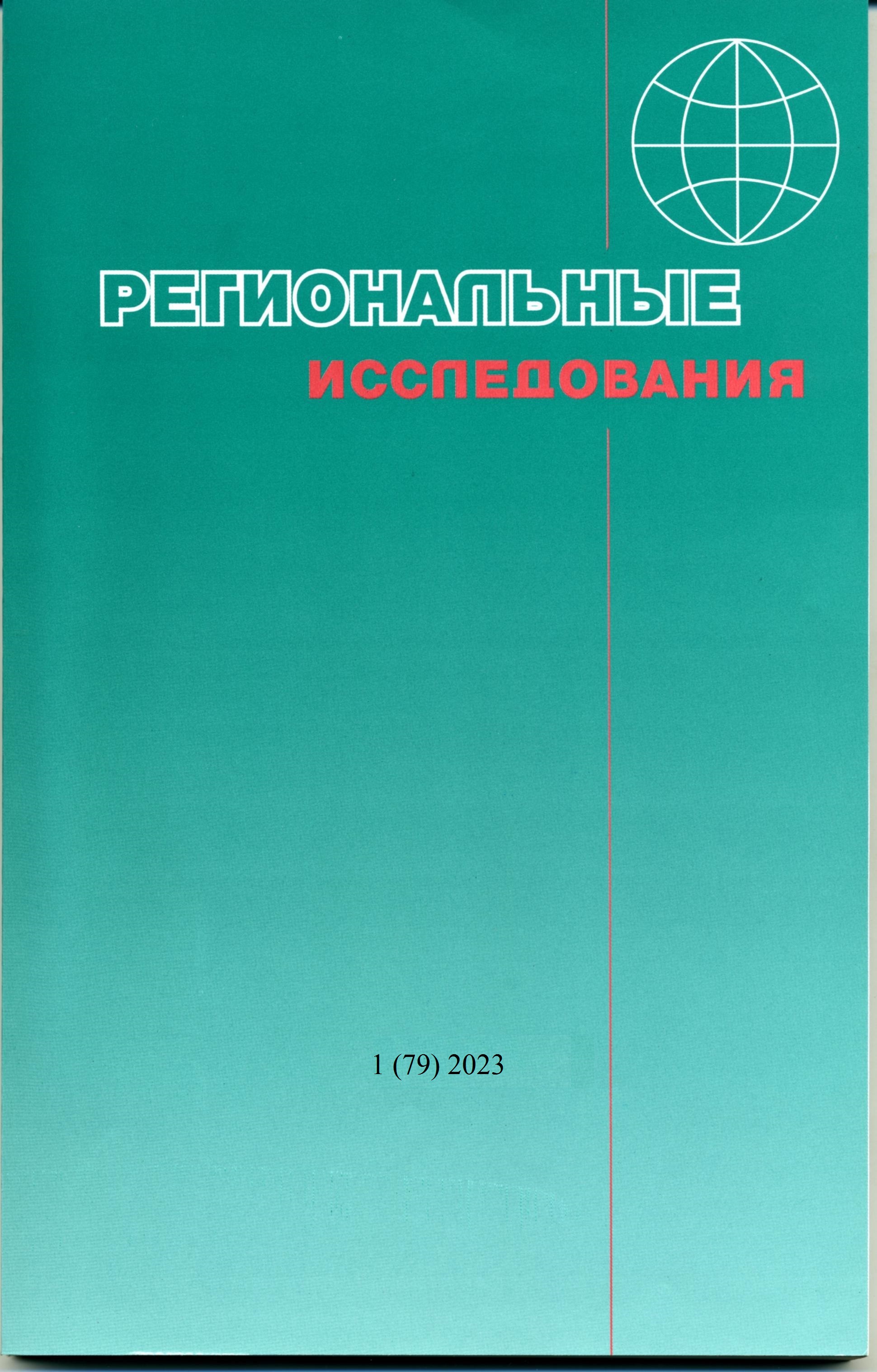Kirillov P.L., Makhrova A.G., Balaban M.O., Gao L. Shrinking cities in post-Soviet Russia
DOI:
https://doi.org/10.5922/1994-5280-2023-1-1Keywords:
post-Soviet Russia, depopulation, shrinking cities, scale and trajectories of urban shrinkageAbstract
The paper is aimed at assessing scale and trends of urban shrinkage in post-Soviet Russia both at national level and by its major regions. Based on the calculation of average annual index of population loss according to population censuses (1989–2021) data, almost half of Russian cities in total have been shrinking for at least one of three intercensal periods. At the same time, in one of three centers the average annual depopulation exceeded 1% at the end of the entire period. In 1989–2002, the number of shrinking cities was not significant (less than a quarter in total), while increasing dramatically in subsequent inter-census periods to over than 1/3 of all urban settlements of the country by 2021. Study of spatial spreading of urban shrinkage phenomenon unveiled that its progress at different stages was mainly contributed either by resource-based cities of the northern and eastern parts of the country, or by urban settlements in old-developed regions, primarily the Non-Chernozyom areas. Absolute majority of all shrinking cities (87%) are minor units with a population under 50,000 inhabitants. Taking into account the general unfavourability of depopulation and the instability and variability of trends, six types of urban shrinkage trajectories with various combinations and alternations of depopulation phases were identified based on the sequence of depopulation phases within each of the three intercensal periods.
Financing
The article was prepared within the framework of the state budget theme of the Research Institute of Geography, Faculty of Moscow State University named after M.V. Lomonosov No. 1.17 "Modern dynamics and factors of socio-economic development of regions and cities of Russia and the Near Abroad."
References
Город и деревня в Европейской России: Сто лет перемен. Под ред. П.М. Поляна, А.И. Трейвиша, Т.Г. Нефедовой. М.: ОГИ, 2001. 557 с.
Гунько М.С., Еременко Ю.А., Батунова Е.Ю. Стратегии планирования в условиях городского сжатия в России: исследование малых и средних городов // Мир России. 2020. № 3. С. 121–141.
Ефремова В.А. Отечественный и зарубежный опыт изучения городов, теряющих население: тематика, методы и центры исследований // Региональные исследования. 2015. № 3. С. 86–98.
Ефремова В.А. Проявления «сжатия» во внутренней территориальной структуре малых и средних городов Ивановской области // Трансформация социально-экономического пространства Евразии в постсоветское время. Т. 1. Барнаул: Алтайский гос. ун-т, 2014. С. 152–161.
Землянский Д.Ю., Ламанов С.В. Сценарии развития монопрофильных городов России // Вестн. Моск. ун-та. Сер. 5. География. 2014. № 4. С. 69–74.
Карачурина Л.Б., Мкртчян Н.В. Роль миграции в усилении контрастов расселения на муниципальном уровне в России // Изв. РАН. Сер. геогр. 2016. № 5. С. 46–59.
Трейвиш А.И. Город, район, страна и мир. М.: Новый хронограф, 2009. 376 с.
Шманкевич Т.Ю. «Сжимающийся» город – новая сегрегация. // Байкальская Сибирь: из чего складывается стабильность. М.; Иркутск: Наталис, 2005. С. 295–307.
Averkieva K., Efremova V. Urban shrinkage in Russia Concepts and causes of urban population loss in the post-Soviet period // Postsocialist Shrinking Cities. London: Routledge, 2022. P. 147–159.
Batunova E., Gunko M. Urban shrinkage: an unspoken challenge of spatial planning in Russian small and medium-sized cities // European Planning Studies. 2018.№ 26 (8). P. 1580–1597.
Batunova E., Gunko M. Diverse landscape of urban and regional shrinkage in Russia preconditions versus preconceptions in planning and policy // Postsocialist Shrinking Cities. London: Routledge, 2022. P. 160–177.
Bernt M. The limits of shrinkage: conceptual pitfalls and alternatives in the discussion of urban population loss // International Journal of Urban and Regional Research. 2016. № 40 (2). P. 441–450.
Cottineau C. A Multilevel Portrait of Shrinking Urban Russia [Электр. ресурс] // Espace, Populations, Sociйtйs. 2016. URL: https://journals.openedition.org/eps/6123 (дата обращения: 21.02.2023).
Haase A., Bernt M., Grossmann K., Mykhnenko V., Rink D. Varieties of shrinkage in European cities // European Urban and Regional Studies. 2016. № 23 (1). P. 86–102.
Haase A., Rink D., Grossmann K., Bernt M., Mykhnenko V. Conceptualizing urban shrinkage // Environment and Planning A. 2014. № 46. P. 1519–1534.
Pallagst K. Shrinking cities in the United States of America // The Future of Shrinking Cities: Problems, Patterns and Strategies of Urban Transformation in a Global Context. Los Angeles: University of California. 2009. P. 81–88.
Pallagst K., Mulligan H., Cunningham-Sabot E., Fol S. The shrinking city awakens: perceptions and strategies on the way to revitalisation? // Town Planning Review. 2017. № 88 (1). P. 9–13.
Postsocialist Shrinking Cities. Ed. by C.-T. Wu, M. Gunko, T. Stryjakiewicz, K. Zhou, London: Routledge, 2022. 392 p. DOI: 10.4324/9780367815011.
Ryan B.D., Gao S. Plan implementation challenges in a shrinking city // J. Am. Plann. Assoc. 2019. № 85. P. 424–444. DOI: 10.1080/01944363.2019.1637769.
Rumpel P., Slach O. Shrinking cities in Central Europe // Transitions in Regional Science-Regions. In Transitions: Regional Research in Central Europe. Publisher: Wolter Kluwer, 2014. P. 142–155.
Shrinking Cities: International Research. Volume 1. / Ed. by Oswalt P. Hatje Cantz: Verlag, 2005. 735 p.
Shrinking Cities. International Perspectives and Policy Implications. Ed. by K. Pallagst, T. Wiechmann, C. Martinez-Fernandez. New York: Routledge, 2013. P. 334. DOI: 10.4324/9780203597255
Turok I., Mykhnenko V. The trajectories of European cities, 1960–2005 // Cities. 2007. № 24 (3). P. 165–182.
Weaver R., Bagchi-Sen S., Knight J., Frazier A. E. Shrinking Cities: Understanding Urban Decline in the United States. New York, NY: Routledge. 2017. 244 p.
Wiechmann T. Errors expected – aligning urban strategy with demographic uncertainty in shrinking cities // International Planning Studies. 2008. №13 (4). P. 431–446.
Wolff M., Wiechmann T. Urban growth and decline: Europe’s shrinking cities in a comparative perspective 1990–2010 // European Urban and Regional Studies. 2018. Vol. 25. № 2. P. 122–139.

